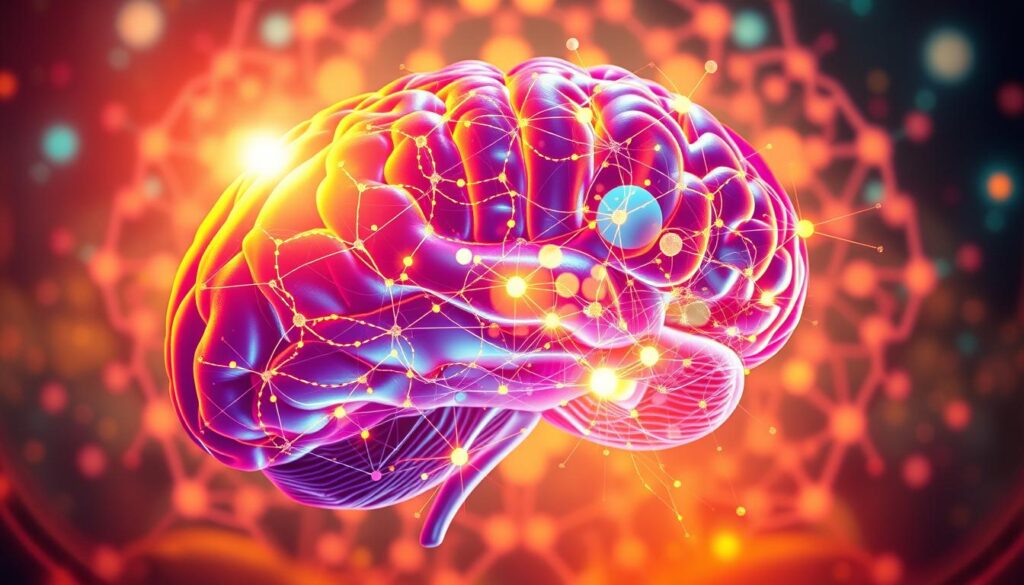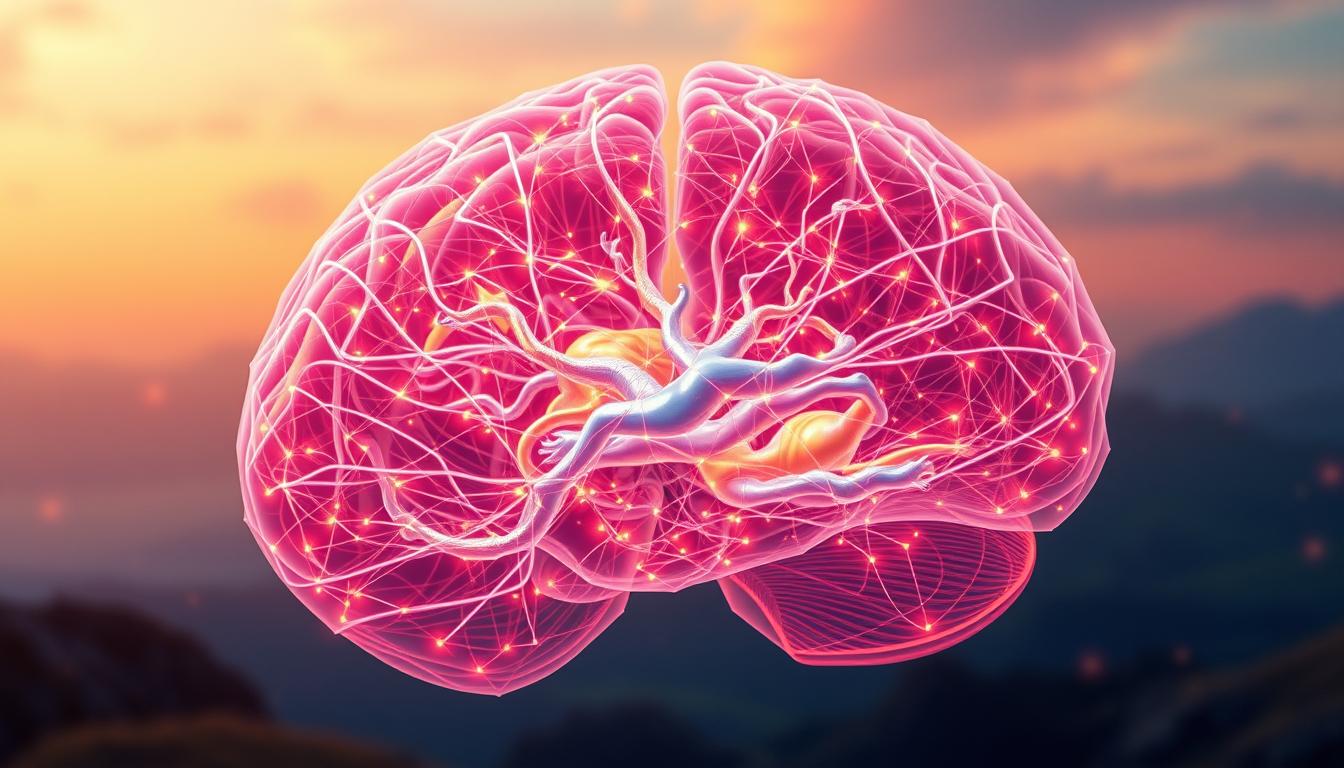Did you know that your thoughts have the power to shape your reality? Neuroplasticity, the brain’s ability to adapt, allows you to rewire your mind for better mental health1. This concept, backed by experts like Samantha Carter, shows how daily thoughts influence emotions and actions.
Scientific research highlights that techniques like meditation and Cognitive Behavioral Therapy (CBT) can transform brain chemistry2. For instance, CBT has shown effectiveness in reducing anxiety and depression symptoms in numerous clinical studies.
Understanding the connection between mind, body, and emotion is key to gaining control over your mental well-being. By harnessing your brain’s power, you can enhance your mental health and improve your daily experiences.
Key Takeaways
- Your thoughts significantly influence your emotions and actions.
- Neuroplasticity allows the brain to form new neural connections throughout life.
- Mindfulness meditation and CBT can effectively alter negative thought patterns.
- Understanding the interplay between mind, body, and emotion is crucial for mental health.
- Improving mental health can lead to a more positive daily experience.
Understanding the Science Behind Brain Health
Neuroplasticity, the brain’s remarkable ability to adapt and change, is a cornerstone of brain health. This concept, backed by research from Psychology Today3, explains how our experiences and thoughts shape the brain’s structure and function over time. The brain’s adaptability allows it to form new neural connections, strengthening frequently used pathways while pruning weaker ones4.
Exploring Neuroplasticity and the Brain’s Adaptability
Scientific studies have shown that neural pathways can be remodeled throughout one’s life. For instance, synaptic pruning eliminates weak connections, making the brain more efficient4. This process is crucial for learning and memory, as it refines and strengthens the connections that matter most.
How Upbringing, Culture, and Trauma Shape Your Thoughts
Environmental factors significantly influence thought patterns. Chronic exposure to cultural and traumatic experiences can create habitual ways of thinking, as noted by Discover Magazine4. For example, repeated stress can alter the brain’s structure, leading to heightened stress responses.
| Type of Neuroplasticity | Description | Example |
|---|---|---|
| Passive (Experience-Dependent) | Unconscious adaptation to environment | Developing a fear of heights after a fall |
| Active (Self-Directed) | Conscious effort to change thoughts | Using meditation to reduce anxiety |
Understanding these processes empowers individuals to take control of their mental health, emphasizing the brain’s ability to adapt and change. By harnessing neuroplasticity, one can enhance their mental well-being and improve daily experiences.
Strategies to Rewire Your Brain for Optimal Health
Discover how simple, evidence-based strategies can transform your mental well-being. By incorporating techniques like mindfulness meditation and cognitive behavioral therapy, you can take control of your thoughts and emotions. These practices, supported by research from Healthline and the Mayo Clinic, offer practical steps to enhance your brain’s adaptability and improve your overall condition.
Mindfulness Meditation and Cognitive Behavioral Therapy Techniques
Mindfulness meditation is a powerful tool for reducing stress and anxiety. Studies show it can lower stress levels by about 30%5. To practice mindfulness:
- Sit quietly, focusing on your breath.
- When your mind wanders, gently bring it back without judgment.
- Start with just 10 minutes a day and gradually increase as you become more comfortable.
Using Affirmations, Gratitude Journaling, and Visualization
Affirmations and gratitude journaling can help replace negative thoughts with positive ones. For example, writing down three things you’re grateful for each day can boost optimism by up to 25%5. Visualization also plays a role in reshaping thought patterns. Imagine yourself achieving your goals to build confidence and motivation.
Consistent practice of these techniques strengthens new neural pathways, leading to lasting mental and physical benefits. By integrating them into your daily routine, you can enhance your overall well-being and create a healthier, more positive mindset.

Rewire Your Reality: Understanding Brain Health for a Better You
Self-directed neuroplasticity is a powerful tool for transforming habitual patterns. By actively reshaping your neural networks, you can replace negative thought cycles with positive, empowering ones. This process, as noted by Dr. Jeffrey Schwartz and Dr. Rick Hanson, relies on sustained effort and reflection to reinforce new, beneficial behaviors6.
The Role of Self-Directed Neuroplasticity in Transforming Habitual Patterns
The science behind self-directed neuroplasticity reveals that intentional mental exercises can restructure deep-seated patterns. For instance, studies show that it can take between 18 and 254 days to form a new habit7. Consistent reflection and goal-setting are key to instilling these new thought processes, helping you stay on track toward lasting change.
Targeted brain activities, such as mindfulness meditation, support the reorganization of neural connections. Visualization, for example, can create neuronal activity similar to actual performance, aiding in behavior transformation8. These techniques not only yield measurable results in brain health but also promote a balanced mental system.

Embrace this journey of self-directed neuroplasticity to enhance your day-to-day experiences and long-term mental well-being. With dedication, you can harness your brain’s ability to change, leading to a healthier, more positive you.
Implementing Evidence-Based Practices in Daily Life
Creating a balanced routine that supports brain function and emotional well-being is easier than you think. By combining physical activities, mindful breathing, and nutritious eating, you can set the stage for optimal mental clarity and resilience.
Integrating Physical Exercise, Breathwork, and Proper Nutrition
Regular physical exercise boosts blood flow to the brain by up to 20%9, enhancing focus and concentration. Pair this with mindful breathing exercises, which can reduce stress and improve emotional regulation. A diet rich in antioxidants and omega-3 fatty acids supports cognitive performance and mood balance.
| Practice | Benefit | Example |
|---|---|---|
| Physical Exercise | Improves blood flow and cognitive function | 30-minute daily walk |
| Conscious Breathing | Reduces stress and anxiety | 5-minute mindfulness session |
| Balanced Nutrition | Supports brain health and mood | Salmon and leafy greens |
Incorporating Music Therapy, Nature Immersion, and Creative Expression
Engaging in music therapy can uplift your mood and reduce stress. Spending time in nature enhances emotional well-being, while creative activities like art or writing stimulate new neural pathways. Combining these practices with regular exercise strengthens mental resilience and overall health.
By integrating these evidence-based practices, you can create a holistic approach to mental well-being, reducing the risk of disease and enhancing your quality of life. A balanced lifestyle is key to achieving your goal of a healthier, more resilient mind.
Understanding Habit Formation and the Habit Loop
Habits are automatic behaviors that develop over time through consistent repetition. According to research from the Massachusetts Institute of Technology, the habit loop consists of three core components: cue, routine, and reward10.
The Cue-Routine-Reward Process Explained
The process begins with a cue, which is a trigger that sets off the habit. This could be something like feeling stressed or hearing a specific sound. The routine is the action you take in response to the cue, such as reaching for a snack or checking your phone. Finally, the reward is the benefit you get from the routine, like a temporary feeling of relaxation or distraction10.
For example, if you always scroll through social media when you feel bored, the boredom is the cue, scrolling is the routine, and the reward is the temporary escape from monotony11.
| Component | Description | Example |
|---|---|---|
| Cue | A trigger that initiates the habit | Feeling stressed |
| Routine | The action taken in response to the cue | Checking social media |
| Reward | The benefit received from the routine | Temporary distraction |
Leveraging Self-Reflection and Journaling to Build Healthy Habits
Self-reflection and journaling are powerful tools for changing habits. By identifying the cues and rewards driving your behaviors, you can replace unhealthy routines with positive ones. For instance, if you often snack when stressed, journaling can help you recognize this pattern and choose a healthier option, like taking a short walk11.
Research shows that self-monitoring significantly increases the likelihood of long-term behavior change. Writing down your habits and the triggers behind them can make you more aware of your actions and help you make better choices10.
Advanced Techniques and Emerging Research in Neuroplasticity
Emerging research is unlocking new ways to enhance brain adaptability through cutting-edge techniques. These methods are transforming how we approach mental and neurological challenges, offering hope for those seeking to improve their cognitive function and overall well-being.
Utilizing Neurofeedback, Stellate Ganglion Block, and Hypnosis
Neurofeedback training allows individuals to monitor and control their brain activity in real-time, promoting positive changes in neural pathways12. Stellate Ganglion Block, a procedure that resets the body’s fight-or-flight response, has shown promise in treating conditions like PTSD13. Hypnosis, supported by recent studies, is gaining recognition for its ability to influence deep-seated behaviors and thought patterns14.
How Technology is Revolutionizing Brain Health Research
Technological advancements are merging traditional practices with digital tools, creating powerful new approaches. Virtual Reality (VR) and gamified rehabilitation are enhancing motor recovery by engaging users in immersive activities that stimulate neuroplasticity12. These innovations are making brain health more accessible and effective than ever before.
By integrating these advanced methods, individuals can create new neural pathways and refine habit change processes. Clinical examples demonstrate the power of these techniques in addressing conditions and preventing diseases, offering personalized options based on individual needs1213.
Conclusion
In conclusion, the power of neuroplasticity offers a transformative path to reshaping your mental landscape. By embracing evidence-based strategies like mindfulness meditation and cognitive behavioral therapy, you can create new neural pathways that foster resilience and well-being. Remember, every setback is a stepping stone, providing insights that guide you closer to your objectives. The journey to a healthier mind involves consistent mental exercise and practical methods, opening doors to a world of possibilities. The ultimate reward lies in the enduring experience of a balanced mind and body, supported by ongoing research and study in the field15.
FAQ
What is neuroplasticity, and how does it impact brain function?
How does mental health influence overall brain health?
What role does nutrition play in maintaining brain health?
Can brain health be improved through physical exercise?
How does music therapy impact brain health?
What are the benefits of practicing gratitude journaling?
How can someone incorporate mindfulness into their daily routine?
What is the connection between emotions and brain health?
How does sleep quality affect brain health?
What are the benefits of cognitive behavioral therapy (CBT) for brain health?
Source Links
- Unlock the Power of CBT to Rewire Your Brain | THE BEHAVIOUR INSTITUTE – https://thebehaviourinstitute.com/unlock-the-power-of-cbt-to-rewire-your-brain/
- Rewire Your Reality with Stephan Spencer – https://www.getyourselfoptimized.com/rewire-your-reality-with-stephan-spencer/
- Rewiring Your Brain: Harnessing Neuroplasticity For Success – https://mindlabneuroscience.com/rewiring-your-brain/
- How Brain Neurons Change Over Time From Life Experience – https://www.verywellmind.com/what-is-brain-plasticity-2794886
- How to Retrain Your Brain for Success | University of St. Augustine for Health Sciences – https://www.usa.edu/blog/how-to-retrain-your-brain/
- The Science of Habit: How to Rewire Your Brain – https://www.healthline.com/health/the-science-of-habit
- Break the Habit – How to Rewire Your Brain for Better Health – Innovative Medicine – https://innovativemedicine.com/break-the-habit-how-to-rewire-your-brain-for-better-health/
- Neuroplasticity: How to rewire your brain – https://www.bbc.com/reel/video/p098v92g/neuroplasticity-how-to-rewire-your-brain
- Strategies For Training Your Brain To Focus – FasterCapital – https://fastercapital.com/topics/strategies-for-training-your-brain-to-focus.html
- The Neuroscience of Habit Formation: How to Use Brain Science to Build Better Habits and Solve Problems – https://www.joincarbon.com/blog/the-neuroscience-of-habit-formation
- The Habit Code: Cracking It For Good With Neuroscience – https://mindlabneuroscience.com/the-habit-code-cracking-it-neuroscience/
- Innovative Approaches and Therapies to Enhance Neuroplasticity and Promote Recovery in Patients With Neurological Disorders: A Narrative Review – https://pmc.ncbi.nlm.nih.gov/articles/PMC10425702/
- Adaptive Neuroplasticity in Brain Injury Recovery: Strategies and Insights – https://pmc.ncbi.nlm.nih.gov/articles/PMC10598326/
- Towards an understanding of psychedelic-induced neuroplasticity – Neuropsychopharmacology – https://www.nature.com/articles/s41386-022-01389-z
- Lab #7: The Science Of Rewiring Your Brain For Success – https://medium.com/the-savanna-post/lab-7-the-science-of-rewiring-your-brain-for-success-b1fad31e4c5e




